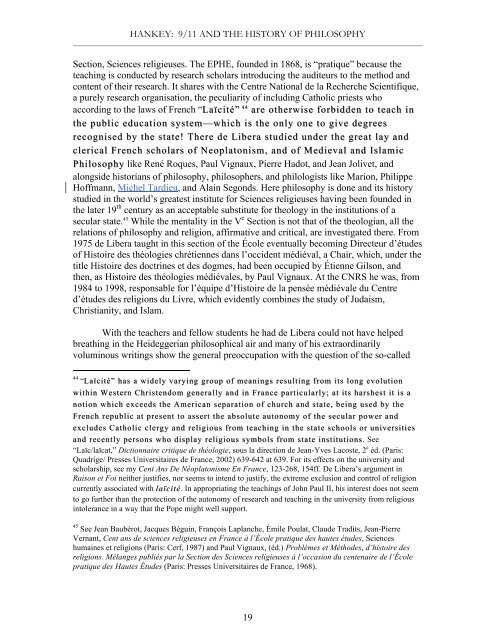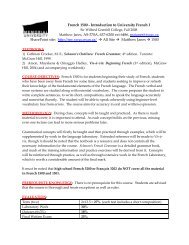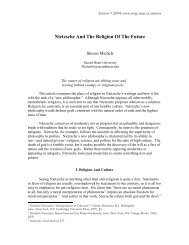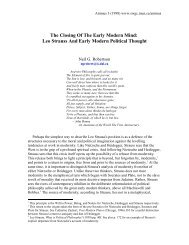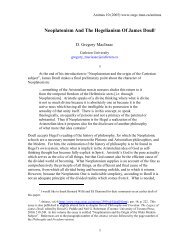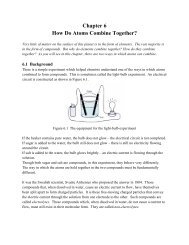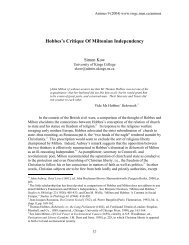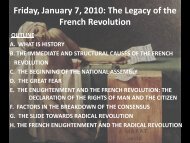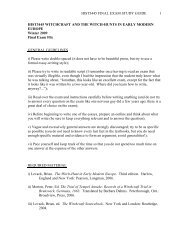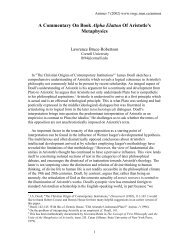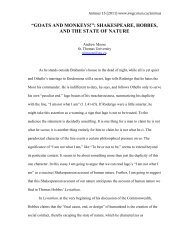Wayne Hankey, 9/11 and the History of Philosophy - Memorial ...
Wayne Hankey, 9/11 and the History of Philosophy - Memorial ...
Wayne Hankey, 9/11 and the History of Philosophy - Memorial ...
You also want an ePaper? Increase the reach of your titles
YUMPU automatically turns print PDFs into web optimized ePapers that Google loves.
HANKEY: 9/<strong>11</strong> AND THE HISTORY OF PHILOSOPHYSection, Sciences religieuses. The EPHE, founded in 1868, is “pratique” because <strong>the</strong>teaching is conducted by research scholars introducing <strong>the</strong> auditeurs to <strong>the</strong> method <strong>and</strong>content <strong>of</strong> <strong>the</strong>ir research. It shares with <strong>the</strong> Centre National de la Recherche Scientifique,a purely research organisation, <strong>the</strong> peculiarity <strong>of</strong> including Catholic priests whoaccording to <strong>the</strong> laws <strong>of</strong> French “Laïcité”44 are o<strong>the</strong>rw ise forbidden to teach in<strong>the</strong> public education system— which is <strong>the</strong> only one to give degreesrecognised by <strong>the</strong> state! There de Libera studied under <strong>the</strong> great lay <strong>and</strong>clerical French scholars <strong>of</strong> Neoplatonism, <strong>and</strong> <strong>of</strong> Medieval <strong>and</strong> Islamic<strong>Philosophy</strong> like René Roques, Paul Vignaux, Pierre Hadot, <strong>and</strong> Jean Jolivet, <strong>and</strong>alongside historians <strong>of</strong> philosophy, philosophers, <strong>and</strong> philologists like Marion, PhilippeH<strong>of</strong>fmann, Michel Tardieu, <strong>and</strong> Alain Segonds. Here philosophy is done <strong>and</strong> its historystudied in <strong>the</strong> world’s greatest institute for Sciences religieuses having been founded in<strong>the</strong> later 19 th century as an acceptable substitute for <strong>the</strong>ology in <strong>the</strong> institutions <strong>of</strong> asecular state. 45 While <strong>the</strong> mentality in <strong>the</strong> V e Section is not that <strong>of</strong> <strong>the</strong> <strong>the</strong>ologian, all <strong>the</strong>relations <strong>of</strong> philosophy <strong>and</strong> religion, affirmative <strong>and</strong> critical, are investigated <strong>the</strong>re. From1975 de Libera taught in this section <strong>of</strong> <strong>the</strong> École eventually becoming Directeur d’études<strong>of</strong> Histoire des théologies chrétiennes dans l’occident médiéval, a Chair, which, under <strong>the</strong>title Histoire des doctrines et des dogmes, had been occupied by Étienne Gilson, <strong>and</strong><strong>the</strong>n, as Histoire des théologies médiévales, by Paul Vignaux. At <strong>the</strong> CNRS he was, from1984 to 1998, responsable for l’équipe d’Histoire de la pensée médiévale du Centred’études des religions du Livre, which evidently combines <strong>the</strong> study <strong>of</strong> Judaism,Christianity, <strong>and</strong> Islam.With <strong>the</strong> teachers <strong>and</strong> fellow students he had de Libera could not have helpedbreathing in <strong>the</strong> Heideggerian philosophical air <strong>and</strong> many <strong>of</strong> his extraordinarilyvoluminous writings show <strong>the</strong> general preoccupation with <strong>the</strong> question <strong>of</strong> <strong>the</strong> so-called44 “Laïcité” has a widely varying group <strong>of</strong> meanings resulting from its long evolutionwithin Western Christendom generally <strong>and</strong> in France particularly; at its harshest it is anotion which exceeds <strong>the</strong> American separation <strong>of</strong> church <strong>and</strong> state, being used by t heFrench republic at present to assert <strong>the</strong> absolute autonomy <strong>of</strong> <strong>the</strong> secular power <strong>and</strong>excludes Catholic clergy <strong>and</strong> religious from teaching in <strong>the</strong> state schools or universities<strong>and</strong> recently persons who display religious symbols from state institutions. See“Laïc/laïcat,” Dictionnaire critique de théologie, sous la direction de Jean-Yves Lacoste, 2 e éd. (Paris:Quadrige/ Presses Universitaires de France, 2002) 639-642 at 639. For its effects on <strong>the</strong> university <strong>and</strong>scholarship, see my Cent Ans De Néoplatonisme En France, 123-268, 154ff. De Libera’s argument inRaison et Foi nei<strong>the</strong>r justifies, nor seems to intend to justify, <strong>the</strong> extreme exclusion <strong>and</strong> control <strong>of</strong> religioncurrently associated with laïcité. In appropriating <strong>the</strong> teachings <strong>of</strong> John Paul II, his interest does not seemto go fur<strong>the</strong>r than <strong>the</strong> protection <strong>of</strong> <strong>the</strong> autonomy <strong>of</strong> research <strong>and</strong> teaching in <strong>the</strong> university from religiousintolerance in a way that <strong>the</strong> Pope might well support.45 See Jean Baubérot, Jacques Béguin, François Laplanche, Émile Poulat, Claude Tradits, Jean-PierreVernant, Cent ans de sciences religieuses en France à l’École pratique des hautes études, Scienceshumaines et religions (Paris: Cerf, 1987) <strong>and</strong> Paul Vignaux, (éd.) Problèmes et Méthodes, d’histoire desreligions. Mélanges publiés par la Section des Sciences religieuses à l’occasion du centenaire de l’Écolepratique des Hautes Études (Paris: Presses Universitaires de France, 1968).19


